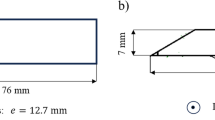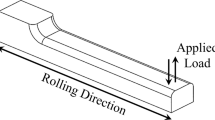Conclusions
-
1.
Rolling of case hardened quenched steel produces an additionally hardened layer as thick as 1 mm. At the same time, the hardness increases by 100 HV units.
-
2.
The effect of rolling depends on the type of steel, the preliminary heat treatment, and the value of the contact stress.
-
3.
The increase in hardness is due to the decomposition of residual austenite and the formation of fine grains of martensite. At the same time, there is an increase in the width of the martensite and austenite x-ray interference lines.
-
4.
For 12Kh2N3MA and 20KhN3A steels, the stress producing hardening is 30,000–35,000 kg/cm2; the optimum contact stress is 45,000–50,000 kg/cm2.
Similar content being viewed by others
Literature cited
G. N. Epshtein, Selection of Parameters for Hardening by Rolling. VNIIBT Reports [in Russian], Moscow, Gostoptekhizdat, 7 (1963).
I. V. Kudryavtsev, Internal Stresses as a Reserve Strength in Machine Construction [in Russian] Moscow, Mashgiz (1951).
I. V. Kudryavtsev and E. V. Rymynova, MiTOM, 10 (1961).
Author information
Authors and Affiliations
Additional information
Translated from Metallovedenie i Termicheskaya Obrabotka Metallov, No. 12. pp. 30, 35–38, December, 1964
Rights and permissions
About this article
Cite this article
Epshtein, G.N., Paisov, I.V. Surface hardening of case hardened steel by rolling. Met Sci Heat Treat 6, 742–745 (1965). https://doi.org/10.1007/BF00660234
Issue Date:
DOI: https://doi.org/10.1007/BF00660234




